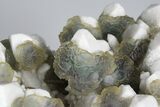5.7" Multi-Colored, Stepped Fluorite on Milky Quartz - Inner Mongolia
This breathtaking specimen features a cluster of milky quartz crystals that are covered in stepped fluorite crystals. The fluorite crystals have a mixture of purple, green and blue coloration within and a stepped-octahedral structure. This specimen comes from the Huanggang Fe-Sn Deposit in Inner Mongolia. The base has been cut flat for presentation purposes.
Under short-wave UV light, the exterior of the fluorite crystals fluoresce a white-purple color.
Under short-wave UV light, the exterior of the fluorite crystals fluoresce a white-purple color.
About Fluorite
Fluorite is a halide mineral comprised of calcium and fluorine, CaF2. The word fluorite is from the Latin fluo-, which means "to flow". In 1852 fluorite gave its name to the phenomenon known as fluorescence, or the property of fluorite to glow a different color depending upon the bandwidth of the ultraviolet light it is exposed to. Fluorite occurs commonly in cubic, octahedral, and dodecahedral crystals in many different colors. These colors range from colorless and completely transparent to yellow, green, blue, purple, pink, or black. Purples and greens tend to be the most common colors seen, and colorless, pink, and black are the rarest.
Fluorite is a halide mineral comprised of calcium and fluorine, CaF2. The word fluorite is from the Latin fluo-, which means "to flow". In 1852 fluorite gave its name to the phenomenon known as fluorescence, or the property of fluorite to glow a different color depending upon the bandwidth of the ultraviolet light it is exposed to. Fluorite occurs commonly in cubic, octahedral, and dodecahedral crystals in many different colors. These colors range from colorless and completely transparent to yellow, green, blue, purple, pink, or black. Purples and greens tend to be the most common colors seen, and colorless, pink, and black are the rarest.
About Quartz
Quartz is the name given to silicon dioxide (SiO2) and is the second most abundant mineral in the Earth's crust. Quartz crystals generally grow in silica-rich environments--usually igneous rocks or hydrothermal environments like geothermal waters--at temperatures between 100°C and 450°C, and usually under very high pressure. In either case, crystals will precipitate as temperatures cool, just as ice gradually forms when water freezes. Quartz veins are formed when open fissures are filled with hot water during the closing stages of mountain formation: these veins can be hundreds of millions of years old.
Quartz is the name given to silicon dioxide (SiO2) and is the second most abundant mineral in the Earth's crust. Quartz crystals generally grow in silica-rich environments--usually igneous rocks or hydrothermal environments like geothermal waters--at temperatures between 100°C and 450°C, and usually under very high pressure. In either case, crystals will precipitate as temperatures cool, just as ice gradually forms when water freezes. Quartz veins are formed when open fissures are filled with hot water during the closing stages of mountain formation: these veins can be hundreds of millions of years old.
$345
SPECIES
Fluorite & Quartz
LOCATION
Huanggang Fe-Sn deposit, Chifeng City, Inner Mongolia, China
SIZE
5.7 x 4.5"
CATEGORY
SUB CATEGORY
ITEM
#179964
 Reviews
Reviews














